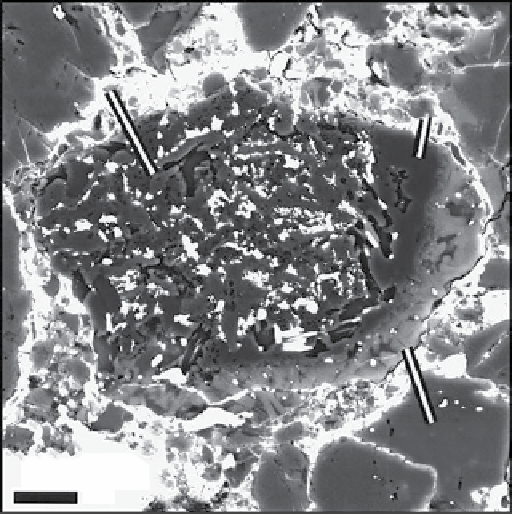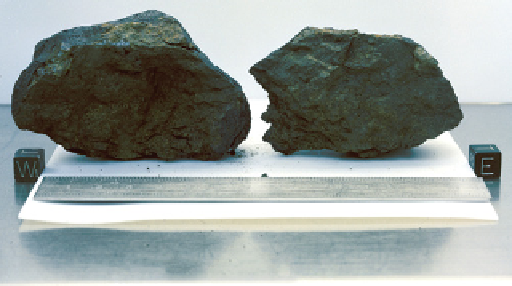Geology Reference
In-Depth Information
EH3 enstatite chondrite
574 g
Found December 19, 1995
7.5 × 7.5 × 6.0 cm
Weathering = C
our meteorite collections and are composed of nearly pure Mg end-
member silicate minerals such as enstatite and metallic FeNi metal that
contains Si. EH chondrites include petrologic types 3 through 6, with
unequilibrated type 3 chondrites providing insight into nebular processes in
a more reduced portion of the solar nebula. Enstatite chondrites also share
the same oxygen isotopic signature as the Earth, the Moon, and aubrites.
GRO 95517, 0
G1724-1
Cor
Sp
10
E4642-1
0
-10
-20
-30
Melilite
Hibonite
Spinel
Pyroxene
Glass
Corundum
Mg-Chondrule
-40
E4631-3
-50
Pyx
-60
-60
5
µ
m
-50
-40
-30
-20
-10
0
10
δ
18
O
SMOW
(‰)
Plate 28
MiNERALogy
SigNiFiCANCE
gRo 95517 contains numerous small chondrules (up to
0.6 mm diameter), CAis, some irregular aggregates, and
many small silicate grains in a black matrix. Trace
amounts of nickel-iron metal and troilite are present as
minute grains. The silicate grains are almost entirely
olivine near Mg
2
Sio
4
in composition, with a few more
iron-rich grains. A little pyroxene near MgSio
3
in compo-
sition is present. The matrix appears to consist largely of
iron-rich serpentine.
Studies of the CAis from gRo 95517 showed that they
are similar in mineralogy, composition, and age to CAis
from other more oxidized meteorites like carbonaceous
and ordinary chondrites (left and right, [190]). Therefore,
the EH CAis either formed early in an oxidized environ-
ment and were later reduced, or they were formed in a
different (oxidized) part of the solar nebula and then later
transported to a more reduced region where enstatite
chondrites were formed. This sample has thus provided
fundamental constraints on the timing and sources of
materials making up primitive meteorites.
References [189-192]








